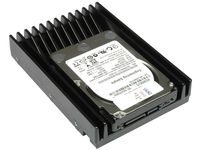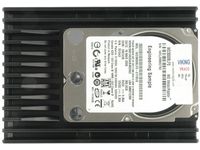Tom’s Winter 2008 Hard Drive Guide
Western Digital: High Performance
Caviar RAID Edition 3 (RE3, WD1002FBYS)
WD’s RAID Edition 3 (RE3), is very similar to the Caviar Black, but was validated for continuous, 24x7 operation. It still delivers slightly better performance than the Caviar Black, at 110 versus 106 MB/s maximum read throughput, with slightly quicker access times. Drive idle power is literally identical with the measurements we took of the Caviar Black, but this does not translate into significant advantages in our performance per watt testing for streaming reads or workstation-type I/O. The RE3 drive is superior when you need a high number of transactions, as you can see in our IOmeter results.
Velociraptor
Enthusiasts are very familiar with the names Raptor and Velociraptor. The Raptor has been Western Digital’s high-end enthusiast and workstation class hard drive for some time. The Velociraptor is the latest version, which WD shrunk into a 2.5” form factor, delivering even quicker access time and improved throughput. The Raptor was a 3.5” drive that launched at 36 and 74 GB before receiving a face lift and capacities of 150 GB. Forget these—if you want maximum hard drive performance, then you want the Velociraptor, at up to 300 GB capacity. WD delivers the 2.5” drive in a 3.5” cooling and installation frame, which allows it to be handled like any other desktop hard drive. The SATA connectors are located at a different position, though, preventing the Velociraptor from being used in hot-swap frames.
The first and most noticeable difference between the 7,200 RPM drives and the Velociraptor is access time and I/O performance. While all 7,200 RPM 3.5” drives deliver 12.1 to 15 ms average access times, the Velociraptor takes only 7 ms on average to access data. It is very strong in the PCMark05 application benchmark, and sets the standard in our I/O performance tests. No other Serial ATA drive provides better overall performance, although the Seagate Barracuda 7200.11 at 1.5 TB delivers better maximum throughput (though it cannot sustain that once you start utilizing the tremendous capacity). Clearly, the Velociraptor is much more suitable as a system drive than a data drive.
We found that lower drive power consumption is a nice byproduct of the 2.5” form factor, as the idle power of 4.4 W is much lower than what we measured with most of the other drives. The only two drives that delivered lower idle power were Samsung’s Eco Green F1 and the WD Caviar Green WD10EADS. The Velociraptor also dominates both performance per watt benchmarks thanks to its low power and high performance. Interestingly, the Caviar Green provides a more balanced result when it comes to streaming read performance per watt, as the Caviar Green is so much lower on power without being too much slower on throughput. The workstation I/O test, however, is the Velociraptor’s domain.
Get Tom's Hardware's best news and in-depth reviews, straight to your inbox.
Current page: Western Digital: High Performance
Prev Page Western Digital: Mainstream and Low Power Next Page HDD Comparison Table


